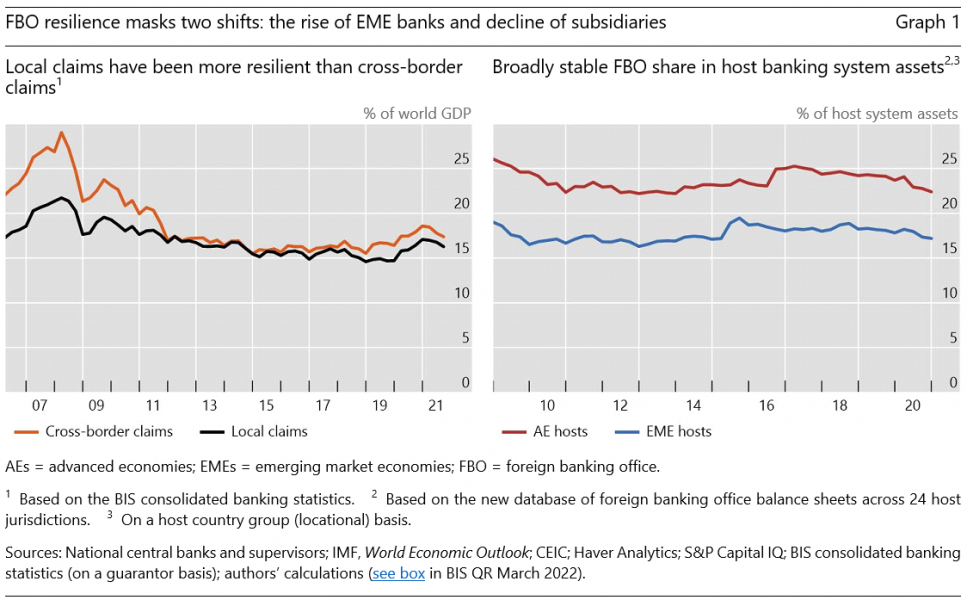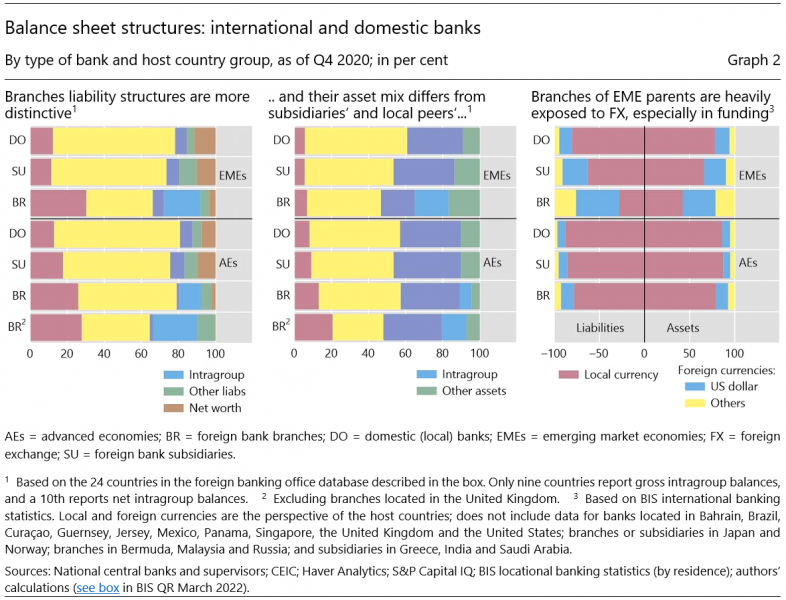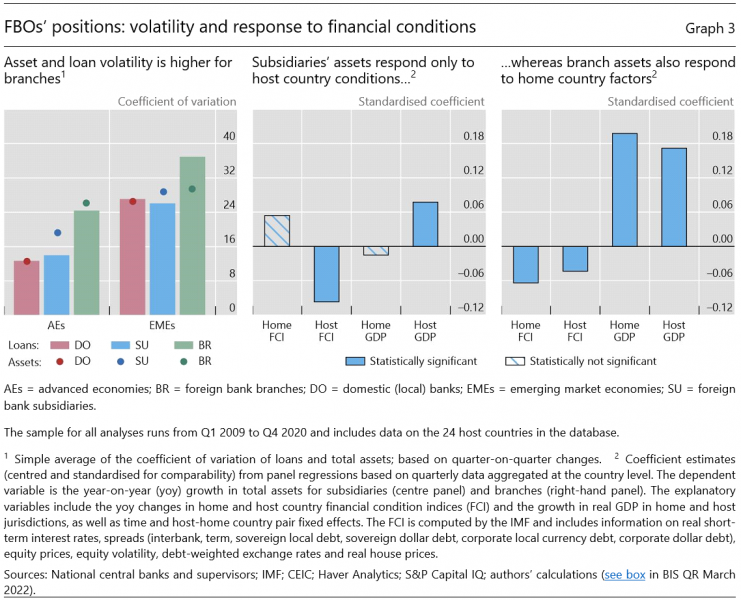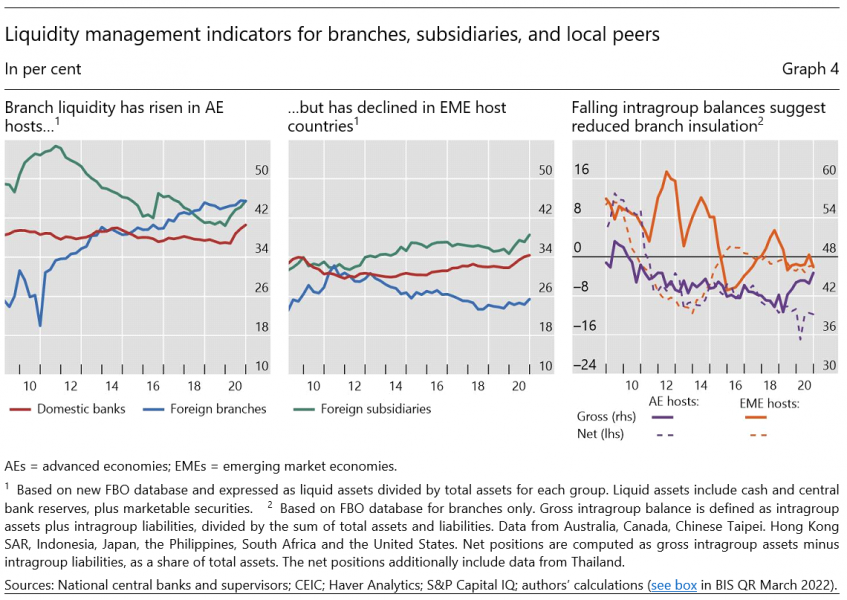

The views expressed in this policy brief belong to the authors and are not necessarily the views of the BIS and the IMF.
Global banks establish their international presence through host-country networks of subsidiaries and branches. These entities’ roles and behaviour are illuminated by their balance sheet positions, but these have not been systematically captured across countries. This brief introduces an attempt to redress that gap with initial findings from system- and entity-level balance sheets across two dozen jurisdictions. Subsidiaries, focused on domestic currency and retail business, appear to be ceding share, while branches, more tailored for flexible international cash management, are maintaining presence. But branches’ positions are more volatile than subsidiaries’, raising concerns for host supervisors. Evidence from the new data suggests host authorities in advanced economies have successfully constrained branch behaviour, but those in emerging economies have not.
Global banks can act outside their home countries in many ways. Buying bonds of an international issuer, participating in a lending syndicate, or lending cross-border to a multinational client’s country operation – these activities channel credit across borders but require no international operational presence. International banks can also serve customers from offices located in foreign countries, providing not only credit but also transaction, treasury and cash management, as well as wealth management services in a range of currencies. Evolution in the mix of business models has changed how the international system behaves, particularly in response to shocks.
The contraction of international lending in the wake of the Great Financial Crisis mainly reflected a shrinkage of cross-border lending. International banks’ foreign offices positions remained stable overall, and as a share of host country banking system assets (Graph 1).

While distinct as a group from peers that operate ‘cross-border’ from home countries, banks with networks of ‘foreign bank offices’ (FBOs) are heterogeneous in their strategies and structures. A centralized global model provides corporates and financial institutions with trade, treasury and cash management and payment services that require significant flexibility in product structuring, currency, booking domicile and liquidity management. A decentralized multinational model, on the other hand, focuses on local currency credit services in multiple countries.
These two business models operate through distinct organizational and legal entity architectures. Centralized global banks operate mainly through international hubs and, if needed, local branch offices that are subsumed within foreign country parents, primarily supervised by home country regulators, and generally without access to local deposit insurance. Decentralized multinational banks operate through local subsidiaries that report to local supervisors and participate in local deposit insurance.
The business conduct and legal status of these foreign offices manifest themselves through differences in balance sheet structure and behavior that largely define their economic significance, particularly for financial stability. The study of FBO balance sheets has been fragmented, reflecting limited and heterogeneous disclosure: extensive work on foreign bank branches in the United States; studies of branch balance sheets in a few other countries; and multi-country work on subsidiaries’ assets and credit provision.2
The BIS has published initial results from a new database of foreign bank office balance sheets that attempts to address these difficulties.3 The database provides time series of standardized balance sheets for foreign bank branches and subsidiaries, and banking system aggregates across 24 host countries. This includes entity-level standardized balance sheets for 16 of the host countries, supplemented with G-SIBs’ country office data in other countries where available.
This database first confirms and broadens a stylized understanding of the differences in the balance sheet structures of foreign bank branches, subsidiaries and domestic banks (Graph 2). Branches are especially distinctive, reflecting their corporate banking focus. This shows particularly for liabilities – much more limited use of deposits, and greater reliance on wholesale and intragroup funding. Branches’ somewhat lower exposure to loans as a share of assets may in part reflect the dearth of deposits, though their intragroup assets (reflecting branches’ function as cross-border liquidity management vehicles) are significant in some countries. Moreover, BIS international banking statistics document that branch offices (particularly in emerging markets) are heavily skewed toward foreign currency balances.
These observations reflect aggregation across a wide group of emerging market and advanced economy banking systems. This level of aggregation may well obscure country- and bank-level patterns that could enrich our understanding of relationships between balance sheet aggregates and countries’ positions in the international financial system, as well as between foreign bank offices’ balance sheet structures and parents’ overall business models.

While we noted earlier that local (i.e., foreign bank office) claims have been more stable than cross-border claims, this obscures two developments. First, foreign bank offices (especially branches) of emerging market parents have grown much faster than those of peers based in developed economies. Secondly, assets of foreign bank branches have grown much faster than subsidiaries. Both developments reflect the growing prominence of Chinese banks, which account for a high proportion of emerging market banks’ share gains and whose foreign office growth has been largely through branches (Graph 3).
The shift from subsidiaries to branches is significant in part because branches are stronger transmitters of risk across borders. Their assets and (especially) loans are more volatile. Moreover, as illustrated by the new database, branches’ asset volatility is more responsive to home country conditions than subsidiaries’ (Graph 4). Host supervisors have long voiced both concerns.

In some countries, hosts have attempted to mitigate risks associated with foreign bank branches by more tightly regulating their behavior. A few have introduced explicit regulation to ‘subsidiarize’ branch operations, moving them within the local regulatory and supervisory perimeter, and in one instance have limited branches’ scope to shift liquidity to and from related offices. Other countries’ authorities may have opted to restrict branch balance sheets through less formal supervisory ‘guidance’.
This is not directly observable but might be inferred from branches’ balance sheets. Rising branch liquidity ratios or reduced intra-group balances (falling gross balances or a shift from net borrowing to net lending) support local prudential regulators but undermine branches’ roles as efficient instruments for international liquidity management. Evidence from the balance sheets of branches and subsidiaries suggests that supervisors in advanced economies have in fact induced foreign branches in their jurisdictions to raise their liquidity ratios, but that hosts in emerging markets have not exerted similar pressure (Graph 4). Furthermore, the limited available evidence suggests that branches net and gross intragroup positions are broadly following a similar trajectory.

In principle, there is no general ‘optimal’ level of local supervisory control over foreign bank offices. Public policy should aim to strike an appropriate balance between the efficiencies associated with branch flexibility and the lower host country risk associated with tighter supervisory control. This posture is difficult to define, particularly as stress conditions fluctuate. However, more granular information, available to both home and host regulators, might improve efforts to balance operational efficiency and risk mitigation. Publication of the banks’ foreign subsidiary and branch office balance sheets could support efforts to develop appropriate policies and standards.
Aldasoro, I, J Caparusso and Y Chen (2022): “Global banks’ local presence: a new lens”, BIS Quarterly Review, March 2022.
Cetorelli, N and L Goldberg (2011): “Liquidity management of U.S. global banks: internal capital markets in the great recession”, NBER Working Papers, no 17355.
Cetorelli, N and L Goldberg (2012): “Banking globalization and monetary transmission”, Journal of Finance, vol 67, no 5.
Fillat, J, S Garett and A Smith (2018): “What are the consequences of global banking for the international transmission of shocks? A quantitative analysis”, NBER Working Papers, no 25203.
Hills, R, J Hooley, Y Korniyenko and T Wieladek (2015): “International banking and liquidity risk transmission: lessons from the United Kingdom”, Bank of England, Staff Working Papers, no 562.
Turtveit, L (2017): “Branches of foreign banks and credit supply”, Norges Bank Economic Commentaries, no 3.
Wong, E, A Tsang and S Kong (2014): “Implications of liquidity management of global banks for host countries – evidence from foreign bank branches in Hong Kong”, HKIMR Working Papers, no 21/2014.
The views expressed in this policy brief belong to the authors and are not necessarily the views of the BIS and the IMF.
See Cetorelli and Goldberg (2011, 2012) and Fillat et al (2018) for the United States, and Hills et al (2015), Turtveit (2017) and Wong et al (2014) for other jurisdictions.
See Aldasoro, Caparusso and Yuan (2022) for a longer treatment of the themes in this brief.